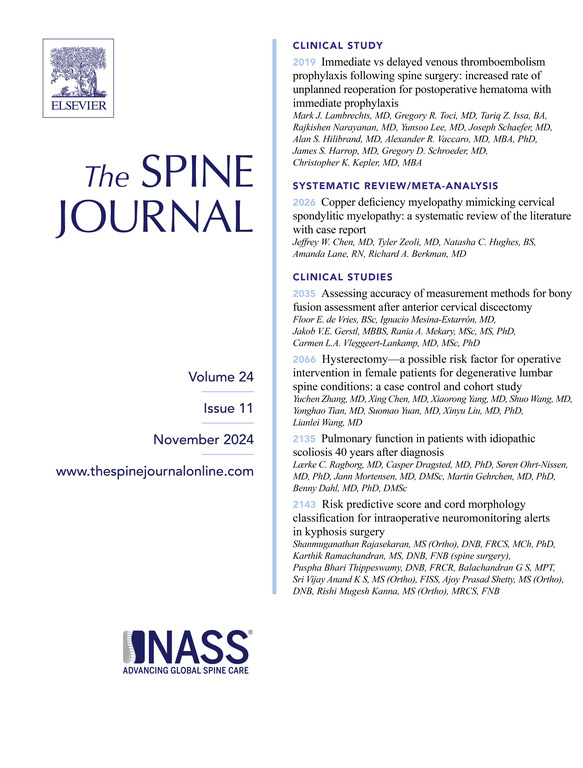治疗腰椎间盘突出症的椎间盘切除术与椎体后凸切除术:系统回顾与荟萃分析。
IF 4.9
1区 医学
Q1 CLINICAL NEUROLOGY
引用次数: 0
摘要
背景情况:腰椎间盘突出症(LDH)是导致腰痛(LBP)和腿痛的主要原因之一,如果出现持续性疼痛和/或神经功能紊乱,可能需要进行手术治疗。传统的椎间盘切除术包括切除椎间盘突出的碎片和椎间盘间隙中的其他物质,这可能会加速椎间盘退变并导致慢性腰背痛。目的:从再疝风险、再手术率、并发症、疼痛、满意度和围手术期结果(手术时间、失血量、住院时间[LOS])等方面比较椎间盘切除术与椎间盘切除术的效果:研究设计:系统回顾和荟萃分析:方法:在 2024 年 5 月 1 日前对 PubMed/MEDLINE 和 Scopus 数据库进行了系统检索。随机和非随机研究。检索根据 PRISMA 指南进行。使用 RoB-2 和 MINORS 工具评估纳入研究的偏倚风险。根据 GRADE 方法对证据质量进行评估:共纳入了 1991 年至 2020 年间发表的 16 篇文章(1 篇随机对照试验和 2 篇随访研究、6 篇前瞻性研究和 7 篇回顾性研究)进行分析,其中包括 2009 名患者。在再疝风险(OR:0.85,95% CI:0.57 至 1.26,P=0.42)、再手术率(OR:0.95,95% CI:0.64 至 1.40,P=0.78)和并发症(OR:1.03,95% CI:0.50 至 2.11)方面,椎间盘切除术与椎体后凸切除术没有明显差异。虽然术后LBP(MD:-0.06,95% CI:-0.39至0.28,P=0.74)和腿痛强度(MD:0.11,95% CI:-0.21至0.42,P=0.50)是相似的,但在 1 年(腿痛:MD:0.37,95% CI:0.19 至 0.54)和 2 年(LBP:MD:0.19,95% CI:0.03 至 0.34,p=0.02;腿痛:MD:0.20,95% CI:0.34,p=0.74)时,采用序贯切除术治疗的患者的预后明显更好:MD:0.20,95% CI:0.09 至 0.31,p=0.0005)。与椎间盘切除术相比,接骨切除术的患者满意度更高(OR:0.60,95% CI:0.40至0.90,P=0.01),手术时间更短(MD:8.71,95% CI:1.66至15.75,P=0.02),而失血量(MD:0.18,95% CI:-2.31至2.67,P=0.89)和LOS(MD:0.02天,95% CI:-0.07至0.12,P=0.60)没有显著差异:根据目前的证据,椎间盘切除术和椎体后凸切除术在再疝风险、再手术率和术后并发症方面没有明显差异。椎间盘切除术和椎间孔镜切除术在再疝风险、再手术率和术后并发症方面没有明显差异。采用椎间孔镜切除术治疗的患者可能会从疼痛改善程度略高、满意度更好和手术时间更短中获益,但这些差异的临床意义还需要更大规模的前瞻性随机研究来验证。本文章由计算机程序翻译,如有差异,请以英文原文为准。
Discectomy versus sequestrectomy in the treatment of lumbar disc herniation: a systematic review and meta-analysis
BACKGROUND CONTEXT
Lumbar disc herniation (LDH) is a leading cause of low back pain (LBP) and leg pain and may require surgical treatment in case of persistent pain and/or neurological deficits. Conventional discectomy involves removing the herniated fragment and additional material from the disc space, potentially accelerating disc degeneration and contributing to chronic LBP. Conversely, by resecting the herniated fragment only, sequestrectomy may reduce postoperative LBP while increasing the risk of LDH recurrence.
PURPOSE
To compare discectomy versus sequestrectomy in terms of risk of reherniation, reoperation rate, complications, pain, satisfaction, and perioperative outcomes (operative time, blood loss, length of stay [LOS]).
STUDY DESIGN
Systematic review and meta-analysis.
METHODS
A systematic search of PubMed/MEDLINE and Scopus databases was performed through May 1, 2024 for both randomized and nonrandomized studies. The search was conducted according to PRISMA guidelines. The RoB-2 and MINORS tools were utilized to assess the risk of bias in included studies. The quality of the evidence was evaluated according to the GRADE approach. Relevant outcomes were pooled for meta-analysis.
RESULTS
A total of 16 articles (1 randomized controlled trial with 2 follow-up studies, 6 prospective studies, and 7 retrospective studies) published between 1991 and 2020 involving 2009 patients were included for analysis. No significant differences were noted between discectomy versus sequestrectomy in terms of risk of reherniation (OR: 0.85, 95% CI: 0.57 to 1.26, p=.42), reoperation rate (OR: 0.95, 95% CI: 0.64 to 1.40, p=.78), and complications (OR: 1.03, 95% CI: 0.50 to 2.11, p=.94). Although LBP (MD: −0.06, 95% CI: −0.39 to 0.28, p=.74) and leg pain intensity (MD: 0.11, 95% CI: −0.21 to 0.42, p=.50) were similar postoperatively, significantly better outcomes were reported by patients treated with sequestrectomy at 1 year (leg pain: MD: 0.37, 95% CI: 0.19 to 0.54, p<.0001) and 2 years (LBP: MD: 0.19, 95% CI: 0.03 to 0.34, p=.02; leg pain: MD: 0.20, 95% CI: 0.09 to 0.31, p=.0005). Sequestrectomy also resulted in a higher patient satisfaction (OR: 0.60, 95% CI: 0.40 to 0.90, p=.01) and shorter operative time (MD: 8.71, 95% CI: 1.66 to 15.75, p=.02), while blood loss (MD: 0.18, 95% CI: −2.31 to 2.67, p=.89) and LOS (MD: 0.02 days, 95% CI: −0.07 to 0.12, p=.60) did not significantly differ compared to discectomy.
CONCLUSIONS
Based on the current evidence, discectomy and sequestrectomy do not significantly differ in terms of risk of reherniation, reoperation rate, and postoperative complications. Patients treated with sequestrectomy may benefit from a marginally higher pain improvement, better satisfaction outcomes, and a shorter operative time, although the clinical relevance of these differences needs to be validated in larger, prospective, randomized studies.
求助全文
通过发布文献求助,成功后即可免费获取论文全文。
去求助
来源期刊

Spine Journal
医学-临床神经学
CiteScore
8.20
自引率
6.70%
发文量
680
审稿时长
13.1 weeks
期刊介绍:
The Spine Journal, the official journal of the North American Spine Society, is an international and multidisciplinary journal that publishes original, peer-reviewed articles on research and treatment related to the spine and spine care, including basic science and clinical investigations. It is a condition of publication that manuscripts submitted to The Spine Journal have not been published, and will not be simultaneously submitted or published elsewhere. The Spine Journal also publishes major reviews of specific topics by acknowledged authorities, technical notes, teaching editorials, and other special features, Letters to the Editor-in-Chief are encouraged.
 求助内容:
求助内容: 应助结果提醒方式:
应助结果提醒方式:


